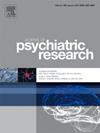Clinical and lifestyle predictors of loneliness: A two-year longitudinal study
IF 3.7
2区 医学
Q1 PSYCHIATRY
引用次数: 0
Abstract
Background
While loneliness is a global public health problem, the literature lacks studies assessing loneliness predictors in low- and middle-income countries. Therefore, we aimed to analyze clinical and lifestyle predictors of loneliness.
Methods
We conducted a 2-year longitudinal study in Brazil based on a snowball sample and online surveys (baseline: May 6 to June 6, 2020). We assessed clinical and lifestyle predictors of loneliness using multiple regression models. The analyses were adjusted for several sociodemographic variables and weighted for attrition and sampling procedures.
Results
The study included a nationwide sample of 473 participants (18–75 years; 87.1% females). After adjusting for sociodemographic factors, we identified as risk factors: depressive symptoms (RR: 1.214; 95%CI: 1.08–1.36; p = 0.001), anxiety symptoms (RR:1.191; 95%CI: 1.04–1.35; p = 0.007), alcohol abuse (RR: 1.579; 95%CI: 1.32–1.88; p < 0.001), and cannabis use (RR: 1.750; 95%CI: 1.25–2.39; p < 0.001). More than 150 min/week of physical activity (RR: 0.177; 95%CI: 0.07–0.34; p < 0.001) and good/excellent quality of family relationships (RR: 0.73; 95%CI: 0.60–0.87; p < 0.001) and sleep (RR: 0.483; 95%CI: 0.39–0.59; p < 0.001) were protective factors.
Conclusion
Several clinical factors (depression, anxiety, alcohol, and cannabis) have been identified as risk factors for loneliness, while lifestyle factors (physical activity, better quality of sleep, and family relationships) have been associated with a lower incidence of loneliness. Addressing clinical and lifestyle factors may therefore be essential to preventing loneliness.
孤独感的临床和生活方式预测因素:一项为期两年的纵向研究
背景:尽管孤独是一个全球性的公共健康问题,但文献中缺乏对中低收入国家孤独感预测因素的评估研究。因此,我们旨在分析孤独感的临床和生活方式预测因素:我们在巴西开展了一项为期两年的纵向研究,研究基于滚雪球抽样和在线调查(基线:2020 年 5 月 6 日至 6 月 6 日)。我们使用多元回归模型评估了孤独感的临床和生活方式预测因素。分析根据几个社会人口变量进行了调整,并根据自然减员和抽样程序进行了加权:该研究在全国范围内抽取了 473 名参与者(18-75 岁;87.1% 为女性)。在对社会人口学因素进行调整后,我们确定了以下风险因素:抑郁症状(RR:1.214;95%CI:1.08-1.36;P = 0.001)、焦虑症状(RR:1.191;95%CI:1.04-1.35;P = 0.007)、酗酒(RR:1.579;95%CI:1.32-1.88;P 结论:该研究发现了一些临床因素(抑郁、焦虑、酗酒):一些临床因素(抑郁、焦虑、酒精和大麻)已被确定为孤独的风险因素,而生活方式因素(体育锻炼、更好的睡眠质量和家庭关系)则与降低孤独发生率有关。因此,解决临床和生活方式因素可能是预防孤独的关键。
本文章由计算机程序翻译,如有差异,请以英文原文为准。
求助全文
约1分钟内获得全文
求助全文
来源期刊

Journal of psychiatric research
医学-精神病学
CiteScore
7.30
自引率
2.10%
发文量
622
审稿时长
130 days
期刊介绍:
Founded in 1961 to report on the latest work in psychiatry and cognate disciplines, the Journal of Psychiatric Research is dedicated to innovative and timely studies of four important areas of research:
(1) clinical studies of all disciplines relating to psychiatric illness, as well as normal human behaviour, including biochemical, physiological, genetic, environmental, social, psychological and epidemiological factors;
(2) basic studies pertaining to psychiatry in such fields as neuropsychopharmacology, neuroendocrinology, electrophysiology, genetics, experimental psychology and epidemiology;
(3) the growing application of clinical laboratory techniques in psychiatry, including imagery and spectroscopy of the brain, molecular biology and computer sciences;
 求助内容:
求助内容: 应助结果提醒方式:
应助结果提醒方式:


